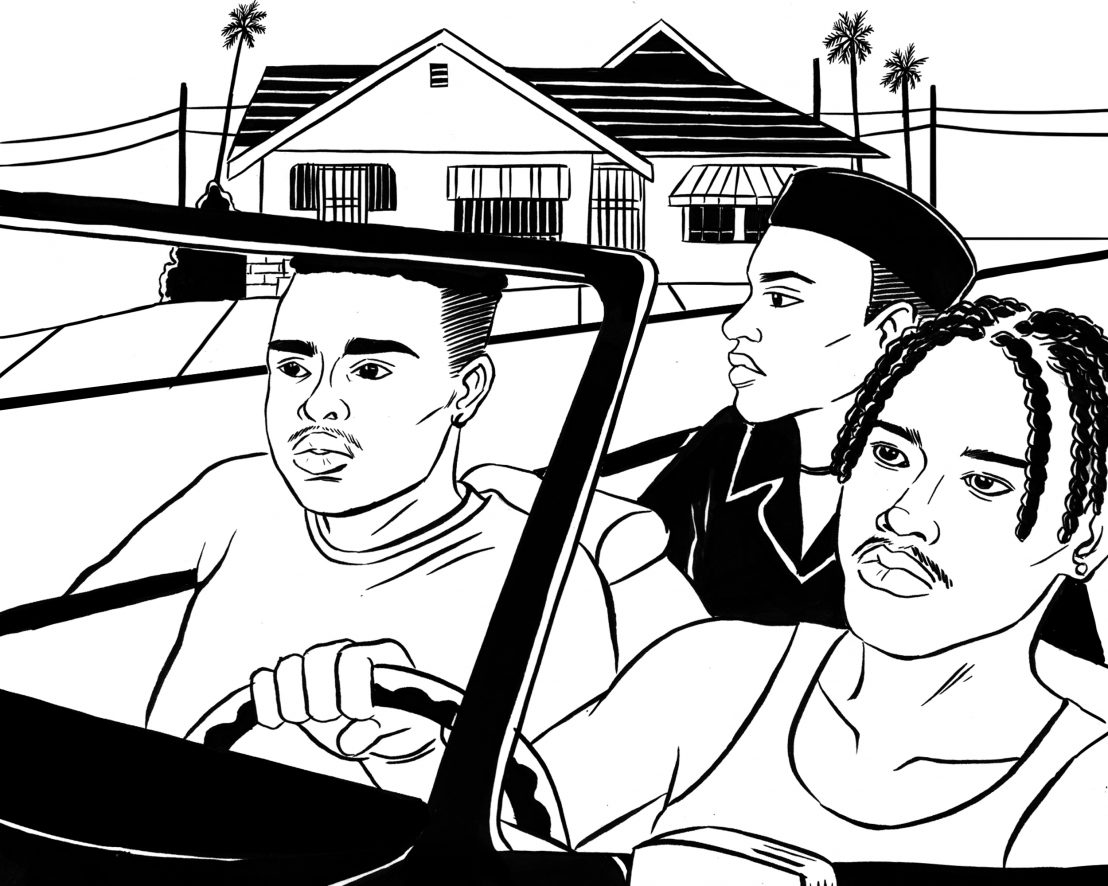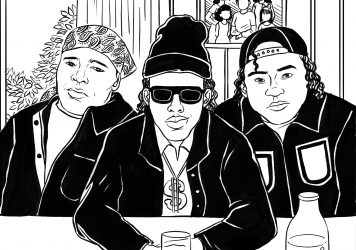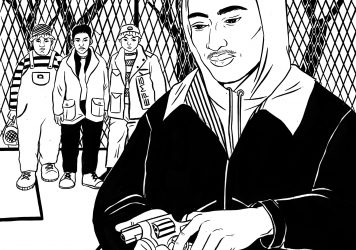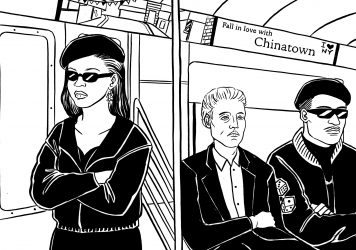
Screenwriter Tyger Williams reflects on the legacy of the Hughes Brothers’ controversial crime saga, which turns 25 this year.
This essay series looks at how five films released during rap’s golden era – King of New York, New Jack City, Juice, CB4 and Menace II Society – helped to shape American hip hop culture. We speak to filmmakers, rappers and historians to find out why these iconic works continue to endure.
When John Singleton’s Boyz n the Hood was released in 1991, it made an instant impact on audiences who were drawn to its emotive story of a kid making it out of South Central Los Angeles and into college. Yet to some the film was a sanitised version of life in the hood, which traded the gritty social commentary present in gangster rap for a far more palatable message of hope.
Released just two years later, Menace II Society took audiences to a far darker place – if both films existed on a 12-inch single, it’s fair to say that Boyz n the Hood would be the radio edit to Menace II Society’s uncut version. “We wanted to make the antithesis to Boyz n the Hood,” reflects screenwriter Tyger Williams, who wrote Menace II Society. “Boyz was all about the one kid who makes it out, but that was just a fairy tale. So many kids never make it out the hood, and I was more interested in telling their story.”
Directed by Allen and Albert Hughes, Menace II Society is a graphic account of life in Watts, LA. It centres on best friends Kane (Tyrin Turner) and O-Dog (a career-best Larenz Tate), two teenagers searching for direction in a neighbourhood that only points one way – straight to the bottom. The Hughes brothers and Williams were in their early twenties when the film was released, and as such it contains an unflinching rawness which you suspect an older filmmaker would have shied away from exploring. Or, as Williams puts it, “We were so young, we hadn’t developed any restraints yet!”
This lack of restraint is apparent from the outset, with the opening scenes showing Kane and O-Dog visiting a local corner shop to buy some beer. They are instantly met with hostility from the Korean proprietors, who harshly scorn them. “Shame on your mother!” When O-Dog replies with the immortal line, “What did you say about my momma?” it’s obvious where things are headed, as the black youth shoots both shop keepers dead and then steals the CCTV recording.
Just two years earlier, 15-year-old schoolgirl Latasha Harlins was shot in the head by Korean convenience store owner Soon Ja Du in South Central LA – a violent crime that occurred just 13 days after the Rodney King beating. Despite the shooting being caught on tape and clearly showing Harlins doing nothing to motivate the attack, Ja Du was sentenced to just 400 hours of community service. This was angrily perceived as an injustice by the hip hop community, with 2Pac perfectly summarising this sentiment in the track ‘Hellrazor’: “Dear Lord if ya hear me, tell me why / Little girl like Latasha, had to die / She never got to see the bullet, just heard the shot / Her little body couldn’t take it, it shook and dropped / And when I saw it on the news I see busta’ girl killin’’Tasha / Now I’m screamin’ fuck the world…”
By reversing the two roles and instead depicting a black youth killing a Korean businessman, Menace II Society actively echoed the frustrations of the hip hop community. And as O-Dog and Kane are later aggressively questioned by the LAPD for their crime, the film questions why the legal system fails to offer up the same empathy and intensity when attempting to bring the killers of black youth to justice. “There’s nothing more subversive than being in your early twenties and making a movie,” says Williams of the notorious corner store scene. “[That scene] was a comment about Latasha but also about the black community reclaiming something, which was really happening as – for right or wrong – Korean stores in LA were getting shot up after Latasha’s murder.”
If Boyz n the Hood’s moral compass is based on cause and effect, then Menace II Society is notable for its proud rejection of one. The acts of violence it depicts are much more random in nature, with anybody from desperate drug addicts to innocent teenagers susceptible to spontaneous drive-by bullets. In this world, death is just around the corner, which makes the idea of salvation seem redundant. At one point, Kane appears apathetic when he’s forced to watch It’s A Wonderful Life with his grandparents, who proudly hang pictures of Jesus Christ on their living room wall. A quarter of a century on, this scene still feels like a damning assessment of the brittle facade of the American Dream.
“Back in the 1990s, every grandma in the hood had a traditional photo of white Jesus hanging on their wall,” says Williams. “But I never understood why we prayed to this idealised image of whiteness, which fails to benefit anyone that looks like you. I wanted to show how the religion that fuels the American dream [in It’s A Wonderful Life] is irrelevant for Kane and his friends.” This is brutally punctuated by the tragic fate of Sharif (Vonte Sweet), a supporting character who bravely rejects gang life for religion, yet still catches a stray bullet to the chest. “Sharif’s death shows blacks kids cannot afford to wait around for a miracle to happen,” suggests Williams. And this bleak backdrop, which rejects the inherently hopeful idea of religion, turns the murderous O-Dog into an unexpected anti-hero, with the teen, who Williams framed on Joe Pesci’s Tommy DeVito in Goodfellas, at least attempting to take his fate into his own hands.
Menace II Society was released during a difficult period for the people of Los Angeles, as tensions boiled over following the perceived injustices around the fates of Rodney King and Latasha Collins. This sparked the Watts riots of ’92, which resulted in the deaths of 50 people. Perhaps inevitably, there was a backlash against Menace II Society, with critics expressing concern that the film would accentuate ugly racial stereotypes and glorify a return to rioting. “Before we made the film, there was a group of powerful African American film producers who wrote a petition against us,” admits Williams.
“They were calling on the head of New Line Cinema to block the release of the film and warned it would result in violent riots as the film was socially irresponsible. We had to shut down filming for a week and were told to add more heart to the film.” Following the film’s release there were several incidents of shootings at public screenings, which Williams describes as “a tragedy” before adding, “We didn’t inspire young black males to shoot up those cinemas – they were inspired by America not caring about them. Our intention wasn’t to glorify violence but to heighten in order to emphasise a societal message, just like Scorsese did with Mean Streets. Look, if O-Dog is your idol then we can’t help you.”
Williams believes that the hostility towards the film stemmed from the fact it tapped into one of Hollywood’s greatest fears – namely, a black man baring arms. He explains, “Steven Seagal could make all these movies where he shoots everyone and on the poster he’s clutching a machine gun, but I remember our promotional poster got changed by the studio. Originally it had O-Dog clutching a gun but this was airbrushed out and they turned his hand into a clenched first. I guess Hollywood was scared to death of a black man holding a gun.” Yet even if the marketing of the film was marred by controversy, the film still found a wide audience, taking $28m at the US box office and winning praise from esteemed critics such as Roger Ebert. It even took home the Best Movie award at the 1994 MTV Movie Awards, ahead of Jurassic Park and Schindler’s List.
Its success felt like a victory for hip hop culture, according to West Coast rap legend (and Watts native) Ras Kass. Citing Kendrick Lamar’s 2012 album ‘Good Kid, M.A.A.D City’ – an album with a narrative structure clearly moulded in Menace II Society’s image – Kass explains how the film opened the door for a whole new generation of rappers to paint a more graphic picture of life in inner city America. “When the crack head in Menace offers to suck O-Dog’s dick in exchange for drugs, that was crazy, as you see that kind of thing every day in the hoods of Watts and Compton,” he says. “For my friends, who were gang members and killers, Menace II Society was more like a documentary than a movie. It inspired me and other rappers [such as Kendrick] as it showed us nothing was off limits in terms of how we could tell our stories. We didn’t have to tone it down.”
According to Daryl ‘DMC’ McDaniels, one third of legendary New York rap group Run DMC, Menace II Society was the “wake-up call hip hop needed”. While he acknowledges that O-Dog can be interpreted as glorifying gun culture, he firmly believes that the film’s haunting ending achieves the opposite: “I think [the film] showed hip hop that all this gangsta stuff is no joke. It’s scary. It’s unpredictable. This ain’t no gangsta rap music fantasy, it’s real out here in these streets. It showed hip hop that it’s not just about making records about the streets, it’s about trying to survive. It made a lot of folks wake up and find a safer, better way to get out of the ghetto, before what happened at the end of the movie happens to you.”
Williams notes that part of the reason why the film has endured is the way it “bravely” equates America’s inner cities to a war zone. He says this was initially a lot more apparent, as “the original poster had a tagline about the average soldier in Vietnam having a better chance of surviving one tour of duty than a kid has to reaching 21 in Watts, Los Angeles.”
But even if the film’s poster ended up being toned down, Menace II Society’s message of horror still filtered through to audiences. As Williams concludes, “I remember going to Blockbuster and someone put a VHS tape of Menace II Society in the horror section. Honestly, that felt like praise to me as Menace was an authentic portrait of the darkest days of our lives. It gave a voice to our horror.”
Published 7 Apr 2018

By Thomas Hobbs
How a low-budget Chris Rock comedy exposed the absurdity of gangsta rap.

By Thomas Hobbs
With its thrilling performances and damning anti-gun message, Ernest Dickerson’s portrait of America continues to touch a nerve.

By Thomas Hobbs
How Abel Ferrara’s brutal 1990 gangster flick captured the imagination of the hip hop community.